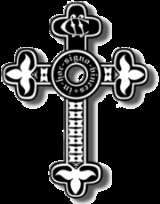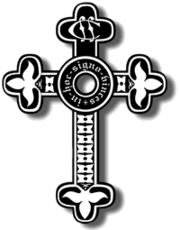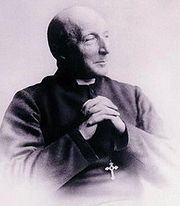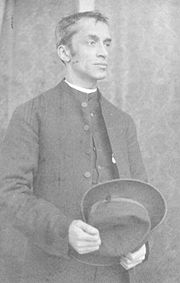
Society of the Holy Cross
Encyclopedia




Anglo-Catholicism
The terms Anglo-Catholic and Anglo-Catholicism describe people, beliefs and practices within Anglicanism that affirm the Catholic, rather than Protestant, heritage and identity of the Anglican churches....
society of priests with members in the Anglican Communion
Anglican Communion
The Anglican Communion is an international association of national and regional Anglican churches in full communion with the Church of England and specifically with its principal primate, the Archbishop of Canterbury...
, the Continuing Anglican Movement
Continuing Anglican Movement
The term Continuing Anglican movement refers to a number of churches in various countries that have been formed outside of the Anglican Communion. These churches generally believe that "traditional" forms of Anglican faith and worship have been unacceptably revised or abandoned within some...
and the Roman Catholic Church
Roman Catholic Church
The Catholic Church, also known as the Roman Catholic Church, is the world's largest Christian church, with over a billion members. Led by the Pope, it defines its mission as spreading the gospel of Jesus Christ, administering the sacraments and exercising charity...
's Anglican Use
Anglican Use
The term Anglican Use has two meanings. First, it refers to parish churches founded by former Episcopalians, members of the United States' branch of the Anglican Communion, who have joined the Catholic Church...
. The society's name is abbreviated as SSC from the initials of the society's Latin name, Societas Sanctae Crucis.
The society is not to be confused with the Roman Catholic Priestly Society of the Holy Cross
Opus Dei: Priestly Society of the Holy Cross
The Priestly Society of the Holy Cross is an association of clergy within the Roman Catholic Church "intrinsically united" to Opus Dei.According to the Annuario Pontificio, there were 1996 priests of the Prelature in the year 2009...
which is an association of Opus Dei
Opus Dei
Opus Dei, formally known as The Prelature of the Holy Cross and Opus Dei , is an organization of the Catholic Church that teaches that everyone is called to holiness and that ordinary life is a path to sanctity. The majority of its membership are lay people, with secular priests under the...
, the Congregation of Holy Cross
Congregation of Holy Cross
The Congregation of Holy Cross or Congregatio a Sancta Cruce is a Catholic congregation of priests and brothers founded in 1837 by Blessed Father Basil Anthony-Marie Moreau, CSC, in Le Mans, France....
, (CSC), another Roman Catholic religious congregation, nor with the Society of the Holy Cross (Korea)
Society of the Holy Cross (Korea)
The Society of the Holy Cross is an order of women religious in the Anglican Church of Korea. It is not to be confused with the Society of the Holy Cross, SSC , which is an international order of Anglo-Catholic priests within the Anglican tradition.The Society's name is abbreviated as SHC....
(SHC), an order of nun
Nun
A nun is a woman who has taken vows committing her to live a spiritual life. She may be an ascetic who voluntarily chooses to leave mainstream society and live her life in prayer and contemplation in a monastery or convent...
s within the Anglican Church of Korea
Anglican Church of Korea
The Anglican Church of Korea is the province of the Anglican Communion in North and South Korea. Founded in 1889, it has over 120 parish and mission churches with a total membership of roughly 65,000 people.-Birth of the Anglican Church of Korea:...
, nor with the Sisters at Tymawr Convent (SSC).
Founding and early history
The society was founded on 28 February 1855 in the chapel of the House of Charity, SohoSoho
Soho is an area of the City of Westminster and part of the West End of London. Long established as an entertainment district, for much of the 20th century Soho had a reputation for sex shops as well as night life and film industry. Since the early 1980s, the area has undergone considerable...
, London
London
London is the capital city of :England and the :United Kingdom, the largest metropolitan area in the United Kingdom, and the largest urban zone in the European Union by most measures. Located on the River Thames, London has been a major settlement for two millennia, its history going back to its...
by six priests: Charles Fuge Lowder
Charles Fuge Lowder
Charles Fuge Lowder was a priest of the Church of England. He was the founder of the Society of the Holy Cross, a society for Anglo-Catholic priests.-Early life:...
, Charles Maurice Davies, David Nicols, Alfred Poole, Joseph Newton Smith and Henry Augustus Rawes. The society they formed was initially intended as a spiritual association for their own personal edification, but it soon came to be the driving force behind the Anglo-Catholic movement, particularly after the first phase of the Oxford Movement
Oxford Movement
The Oxford Movement was a movement of High Church Anglicans, eventually developing into Anglo-Catholicism. The movement, whose members were often associated with the University of Oxford, argued for the reinstatement of lost Christian traditions of faith and their inclusion into Anglican liturgy...
had played its course and John Henry Newman had converted to Roman Catholicism.
Father Lowder was the Founder of the society and served as its first Master. While visiting France in 1854, he conceived of the idea of an order of Anglican priests based on the Lazarists
Lazarists
Congregation of the Mission is a vowed order of priests and brothers associated with the Vincentian Family, a loose federation of organizations who claim St. Vincent de Paul as their founder or Patron...
, a Roman Catholic order founded by St Vincent de Paul
Vincent de Paul
Vincent de Paul was a priest of the Catholic Church who became dedicated to serving the poor. He is venerated as a saint in the Catholic Church and the Anglican Communion. He was canonized in 1737....
. The society provided its members with a rule of life and a vision of a disciplined priestly life. Mutual support has always been a key element and the life of the society is experienced primarily through the local chapter. Attendance at chapter is of obligation unless prevented by genuine pastoral duties.
The society expanded almost immediately. These early priests of the society ministered in some of the poorest slum areas of London and other cities. These included the parishes of: St Barnabas' Pimlico and St Peter's London Docks. Many of these areas were so dangerous that bishops refused to visit them, although their refusal was also motivated by a distaste for the ritualism of the Anglo-Catholic clergy.
Anglo-Catholic ritualism was very close to practices in the Roman Catholic Church
Roman Catholic Church
The Catholic Church, also known as the Roman Catholic Church, is the world's largest Christian church, with over a billion members. Led by the Pope, it defines its mission as spreading the gospel of Jesus Christ, administering the sacraments and exercising charity...
and included devotion to the Blessed Sacrament
Blessed Sacrament
The Blessed Sacrament, or the Body and Blood of Christ, is a devotional name used in the Roman Catholic Church, Eastern Catholic Churches, Old Catholic, Anglican, and Lutheran churches, to refer to the Host after it has been consecrated in the sacrament of the Eucharist...
, frequent celebration of the Mass with intentions, the practice of confession
Confession
This article is for the religious practice of confessing one's sins.Confession is the acknowledgment of sin or wrongs...
, the wearing of eucharistic vestments, and the use of incense
Incense
Incense is composed of aromatic biotic materials, which release fragrant smoke when burned. The term "incense" refers to the substance itself, rather than to the odor that it produces. It is used in religious ceremonies, ritual purification, aromatherapy, meditation, for creating a mood, and for...
, liturgical hand bells and wafer bread. Whilst these practices had not been completely unknown in the Church of England
Church of England
The Church of England is the officially established Christian church in England and the Mother Church of the worldwide Anglican Communion. The church considers itself within the tradition of Western Christianity and dates its formal establishment principally to the mission to England by St...
since its break with the Roman Catholic Church
Roman Catholic Church
The Catholic Church, also known as the Roman Catholic Church, is the world's largest Christian church, with over a billion members. Led by the Pope, it defines its mission as spreading the gospel of Jesus Christ, administering the sacraments and exercising charity...
, most of them had not been in general use for hundreds of years as the Church of England had become increasingly influenced by Protestantism in its liturgical practice during and after the reigns of Edward VI
Edward VI of England
Edward VI was the King of England and Ireland from 28 January 1547 until his death. He was crowned on 20 February at the age of nine. The son of Henry VIII and Jane Seymour, Edward was the third monarch of the Tudor dynasty and England's first monarch who was raised as a Protestant...
and Elizabeth I
Elizabeth I of England
Elizabeth I was queen regnant of England and Ireland from 17 November 1558 until her death. Sometimes called The Virgin Queen, Gloriana, or Good Queen Bess, Elizabeth was the fifth and last monarch of the Tudor dynasty...
.
It is important to note, however, that SSC priests considered these practices an outward, necessary and physical expression of belief and doctrine and not merely as aesthetic adornments to worship. The society was primarily concerned with improving the spiritual life of priests and people. For example, the now common practice of retreats was introduced to the Church of England in those given by SSC priests, beginning in 1856.
Many Low Church
Low church
Low church is a term of distinction in the Church of England or other Anglican churches initially designed to be pejorative. During the series of doctrinal and ecclesiastic challenges to the established church in the 16th and 17th centuries, commentators and others began to refer to those groups...
and Latitudinarian
Latitudinarian
Latitudinarian was initially a pejorative term applied to a group of 17th-century English theologians who believed in conforming to official Church of England practices but who felt that matters of doctrine, liturgical practice, and ecclesiastical organization were of relatively little importance...
churchmen viewed ritualism, and the accompanying teaching, with horror. It was not unusual for Mass and the Divine Office
Liturgy of the hours
The Liturgy of the Hours or Divine Office is the official set of daily prayers prescribed by the Catholic Church to be recited at the canonical hours by the clergy, religious orders, and laity. The Liturgy of the Hours consists primarily of psalms supplemented by hymns and readings...
in SSC parishes to be disrupted by Protestant protesters, some hired for the occasion, shouting during the reading of lessons and the sermon, or hurling furniture and books. Lawsuits were filed against priests for Catholic practices. Some of these prosecutions were successful and priests were suspended from their ministries. In other actions, some Catholic practices were permitted by the courts while others were ruled illegal. Still other practices were sometimes ruled by the civil courts not to be illegal per se but that their continued use would require direct authorisation by the diocesan bishop
Bishop
A bishop is an ordained or consecrated member of the Christian clergy who is generally entrusted with a position of authority and oversight. Within the Catholic Church, Eastern Orthodox, Oriental Orthodox Churches, in the Assyrian Church of the East, in the Independent Catholic Churches, and in the...
.
Public Worship Regulation Act
See: Public Worship Regulation ActThe legal inconsistencies led to the passing of the Public Worship Regulation Act by the Disraeli government in 1874 with the stated aim of "putting down the Ritualists". The act was introduced in the House of Lords
House of Lords
The House of Lords is the upper house of the Parliament of the United Kingdom. Like the House of Commons, it meets in the Palace of Westminster....
as a Private Member's Bill
Private Member's Bill
A member of parliament’s legislative motion, called a private member's bill or a member's bill in some parliaments, is a proposed law introduced by a member of a legislature. In most countries with a parliamentary system, most bills are proposed by the government, not by individual members of the...
by Archibald Tait, the Archbishop of Canterbury
Archbishop of Canterbury
The Archbishop of Canterbury is the senior bishop and principal leader of the Church of England, the symbolic head of the worldwide Anglican Communion, and the diocesan bishop of the Diocese of Canterbury. In his role as head of the Anglican Communion, the archbishop leads the third largest group...
, who had previously served as the Bishop of London
Bishop of London
The Bishop of London is the ordinary of the Church of England Diocese of London in the Province of Canterbury.The diocese covers 458 km² of 17 boroughs of Greater London north of the River Thames and a small part of the County of Surrey...
. After the act came into force, on July 1, 1875, the Church Association
Church Association
The Church Association was an English evangelical Anglican organisation, founded in 1865.It was particularly active in opposition to Anglo-Catholicism, Ritualism and the Oxford Movement.Founded in 1865 by Richard P...
, which had been responsible for some the pre-act lawsuits, began vigorously prosecuting those who persisted in Anglo-Catholic practice and teaching. Seventeen priests were prosecuted under the act. In some cases these priests served time in prison for either not acknowledging the right of the courts to judge them on matters of worship or after being convicted. Occasionally some bishops (including Archbishop Tait) would intervene to stop prosecutions, particularly as public outrage grew at the blatant interference in religious matters by secular courts.
The prosecution of SSC priests Father Arthur Tooth
Arthur Tooth
Arthur Tooth SSC was a Ritualist priest in the Church of England and a member of the Society of the Holy Cross . Tooth is best known for having been prosecuted in 1876 under the Public Worship Regulation Act 1874 for using proscribed liturgical practices...
, Father Alexander Heriot Mackonochie
Alexander Heriot Mackonochie
Alexander Heriot Mackonochie SSC was a Church of England clergyman and mission priest known as "the martyr of St Alban's" on account of his prosecution and forced resignation for ritualist practices.-Early life:...
and Father Richard William Enraght
Richard William Enraght
Richard William Enraght SSC was an Irish-born Church of England priest of the late nineteenth century. He was influenced by the Oxford Movement and was included amongst the priests commonly called “Second Generation” Anglo-Catholics.Fr...
are undoubtedly the most famous episodes in the early history of the SSC.
Subsequent history
The prosecutions, however, were battles won in a losing war. In 1906, a Royal Commission effectively nullified the act by admitting that more pluralism in public worship was needed. The selfless example of SSC priests in ministering to the lowest orders of society and their strong stands on social justice had also endeared them to the general public.Alexander Penrose Forbes
Alexander Penrose Forbes
Alexander Penrose Forbes , Scottish divine, was born at Edinburgh.He was the second son of John Hay Forbes, Lord Medwyn, a judge of the court of session, and grandson of Sir William Forbes of Pitsligo. He studied first at the Edinburgh Academy, then for two years under the Rev. Thomas Dale...
, Bishop of Brechin in the Scottish Episcopal Church
Scottish Episcopal Church
The Scottish Episcopal Church is a Christian church in Scotland, consisting of seven dioceses. Since the 17th century, it has had an identity distinct from the presbyterian Church of Scotland....
from 1847 till his death in 1874, was probably the first of many SSC bishops around the world, including the saintly Frank Weston
Frank Weston
Frank Weston was Anglican Bishop of Zanzibar from 1908 until his death 16 years later.-Biography:...
of Zanzibar.
As a Catholic society, SSC has taken a conservative line in the church controversies of the late 20th century, particularly over the interpretation of scripture and the ordination of women.
Today, there are over 2,000 members of the society organized into provinces for England and Scotland, the Americas, Wales and Australasia, each under a provincial master reporting to an international master-general. The current master general of the society is Father David Houlding who resides in England.
In April 2005, the society celebrated its 150th anniversary with a week-long festival, "Stand Up For Jesus". The Archbishop of Canterbury, Rowan Williams, addressed the gathering and the Royal Albert Hall was filled to capacity for the closing mass.
The fortunes of SSC have waxed and waned since the early days of the Catholic Revival, but for its members it has always been an important source of priestly formation, discipline and fraternity. Priests of the society can be recognised by the small gold lapel cross that they generally wear. On it is inscribed the motto of the society, In Hoc Signo Vinces (In This Sign Conquer).
There is also a section of the society, the Pusey Guild, for seminarians and approved candidates for training for the priesthood.http://www.stpeterslondondocks.org.uk/section/33
See also
- Anglican religious orderAnglican religious orderAnglican religious orders are communities of laity and/or clergy in the Anglican Communion who live under a common rule of life. The members of religious orders take vows of poverty, chastity, and obedience, and lead a common life of work and prayer...
- Anglo-CatholicismAnglo-CatholicismThe terms Anglo-Catholic and Anglo-Catholicism describe people, beliefs and practices within Anglicanism that affirm the Catholic, rather than Protestant, heritage and identity of the Anglican churches....
- Confraternity of the Blessed SacramentConfraternity of the Blessed SacramentThe Confraternity of the Blessed Sacrament is a devotional society in the Anglican Communion dedicated to venerating the Real Presence of Christ in the Eucharist...
- Guild of All SoulsGuild of All SoulsThe Guild of All Souls is an Anglican devotional society dedicated to prayer for faithful departed Christians. As stated on its website, it is a "devotional society praying for the souls of the Faithful Departed, and teaching the Catholic doctrine of the Communion of Saints."-Objectives:The stated...
- Guild of Servants of the SanctuaryGuild of Servants of the SanctuaryThe Guild of Servants of the Sanctuary or GSS is an association of altar servers in the Church of England and the Church in Wales, with some overseas organisation in several other countries.-Objectives and Membership:...
- Ritualism
- Society of Catholic PriestsSociety of Catholic PriestsThe Society of Catholic Priests is a religious society of clergy in the Anglican Communion which draws its membership from Anglicans who consider themselves a part of the Anglo-Catholic tradition of Anglicanism.-Founding and early history:...
- Society of King Charles the MartyrSociety of King Charles the MartyrThe Society of King Charles the Martyr is an Anglican devotional society and one of the Catholic Societies of the Church of England. It is dedicated to and under the patronage of King Charles I of England , the only person to be canonised by the Church of...
- Society of Mary (Anglican)Society of Mary (Anglican)The Society of Mary is an Anglican devotional society dedicated to and under the patronage of the Blessed Virgin Mary. As its website states, it is a group of Anglican Christians "dedicated to the Glory of God and the Holy Incarnation of Christ under the invocation of Our Lady, Help of...
- T. Pelham DaleT. Pelham DaleThomas Pelham Dale was an English Anglo-Catholic ritualist clergyman, most famous for being prosecuted and imprisoned for ritualist practices-Biography:...
- Richard William EnraghtRichard William EnraghtRichard William Enraght SSC was an Irish-born Church of England priest of the late nineteenth century. He was influenced by the Oxford Movement and was included amongst the priests commonly called “Second Generation” Anglo-Catholics.Fr...
- Arthur ToothArthur ToothArthur Tooth SSC was a Ritualist priest in the Church of England and a member of the Society of the Holy Cross . Tooth is best known for having been prosecuted in 1876 under the Public Worship Regulation Act 1874 for using proscribed liturgical practices...
External links
- Historical documents on SSC from Project CanterburyProject CanterburyProject Canterbury is an online archive of material related to the history of Anglicanism. It was founded by Richard Mammana, Jr. in 1999, and is hosted by the non-profit Society of Archbishop Justus...
- Province of England & Scotland
- Province of The Americas
- Province of Wales
- In This Sign Conquer: A History of the Society of the Holy Cross

